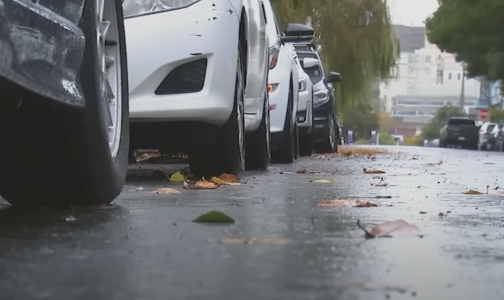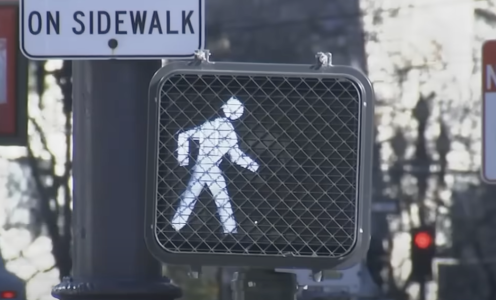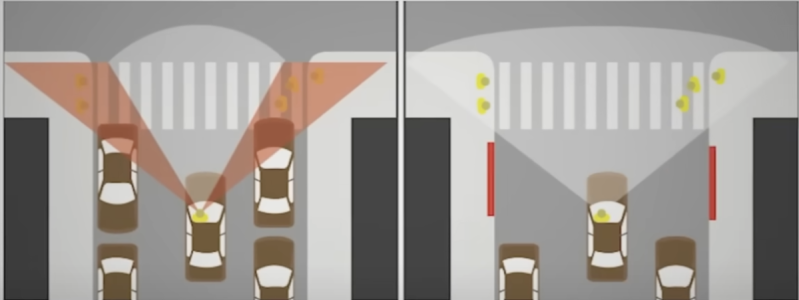The $64 mistake hiding in plain sight—this new law could cost you
- Replies 0
As we cruise through the ever-changing landscape of road regulations, this state’s drivers are adjusting their mirrors to reflect a new law aimed at enhancing street safety.
The “daylighting” law is the latest measure to protect pedestrians and ensure a clear line of sight for motorists. But with new rules come new responsibilities—and potential penalties.
Let's explore what this means for you and how a simple awareness can keep your wallet $64 heavier.
The Dawn of “Daylighting”
California Assembly Bill 413, known as the Daylighting to Save Lives Bill, is like a new traffic signal on the horizon, set to illuminate California’s crosswalks with increased visibility.
The law, which takes effect on January 1, 2025, prohibits drivers from parking within 20 feet of crosswalks, whether these pedestrian paths are marked or unmarked. The 60-day grace period for violations is until March 1, 2025.
The goal behind this law is to clear the way for a safer journey for everyone on the road. The specifics of the law are straightforward: no stopping, standing, or parking within 20 feet of a crosswalk.

to heighten visibility and protect pedestrians and bike riders.
On one-way streets, the same rule applies to the left curb, and where curb extensions are present, the no-parking zone extends to 15 feet.
The Fine Print and How to Avoid It
While the law's intentions are clear, its rollout has been met with some confusion. Initially, drivers faced the threat of an instant $64 ticket for parking too close to crosswalks.
Most drivers, however, are unlikely to receive citations, as the stricter parts of the legislation appear to have been softened.
In earlier news: New parking law takes effect January 1—fines could cost you $64
Under the updated state law, it’s illegal to park too close to crosswalks unless the area is clearly designated as a no-parking zone.
But according to Berkeleyside, local authorities aren’t aggressively enforcing the rule.
Since January, parking officers have primarily been issuing warnings rather than fines for violations related to the “daylighting” law.
In many cases, this rule applies to vehicles parked within 20 feet of a crosswalk in the direction traffic is coming from.

Originally, enforcement was expected to begin this week—including for areas where the curb wasn't painted red or otherwise marked as a no-parking zone.
However, authorities now say that officers will keep issuing warnings for most infractions that occur in unmarked but restricted zones.
Instead, tickets will be reserved for drivers who leave their cars in clearly designated no-parking spots, such as those with red-painted curbs.
The city noted that officers may still issue tickets to “repeat offenders” who continue parking in unmarked daylighting areas.
Officials did not clarify how many times a driver could violate the rule before facing a citation.
The law, which took effect statewide in California at the start of the year, has stirred debate. Public officials across the state have raised concerns that unsuspecting drivers might be penalized for parking in areas that don’t appear restricted.
In Berkeley, for instance, the Public Works Department estimates there are roughly 1,700 curb sections where the now-restricted zones haven’t yet been marked with red paint or signage.
Adding to the confusion, some of these newly off-limits areas still feature parking meters or are designated as loading zones.

The Simple Trick to Avoid the Fine
City spokesperson Matthai Chakko said that officials are emphasizing voluntary compliance.
“The most important thing is not about citations and tickets, but safety,” Chakko stated. “Avoiding parking within daylighting zones helps fellow motorists to uphold one of their principal responsibilities: yielding to pedestrians at a sidewalk. It improves their own line of vision as well as that of fellow drivers.”
Another city spokesperson, Seung Lee, explained that Berkeley police, City Manager Paul Buddenhagen, and the Public Works Department revised their enforcement approach “to reduce confusion, encourage compliance, and stay consistent in enforcement with other nearby cities.”
San Francisco has also pulled back from plans to issue citations for parking in unmarked daylighting zones, citing concerns from transit officials, local supervisors, and new Mayor Daniel Lurie that strict enforcement would be “too punitive.”
Previously, Berkeley officials reported issuing 234 warnings for daylighting violations within the first nine days of the year.
Source: ABC7 News Bay Area / Youtube.
The daylighting law is intended to boost safety by improving drivers’ ability to see pedestrians, as vehicles parked close to crosswalks can obstruct views at intersections.
Read next: Avoid hefty instant fines with these essential April driving law updates you need to know!

Have you already encountered “daylighting” zones in your daily drives? What are your thoughts on the new law? Do you have tips for remembering to keep crosswalks clear? Share your experiences and insights in the comments below!
The “daylighting” law is the latest measure to protect pedestrians and ensure a clear line of sight for motorists. But with new rules come new responsibilities—and potential penalties.
Let's explore what this means for you and how a simple awareness can keep your wallet $64 heavier.
The Dawn of “Daylighting”
California Assembly Bill 413, known as the Daylighting to Save Lives Bill, is like a new traffic signal on the horizon, set to illuminate California’s crosswalks with increased visibility.
The law, which takes effect on January 1, 2025, prohibits drivers from parking within 20 feet of crosswalks, whether these pedestrian paths are marked or unmarked. The 60-day grace period for violations is until March 1, 2025.
The goal behind this law is to clear the way for a safer journey for everyone on the road. The specifics of the law are straightforward: no stopping, standing, or parking within 20 feet of a crosswalk.

A new “daylighting” law has been introduced in California, which could result in a $64 fine for drivers parking too close to crosswalks. Image source: ABC7 News Bay Area / Youtube.
to heighten visibility and protect pedestrians and bike riders.
On one-way streets, the same rule applies to the left curb, and where curb extensions are present, the no-parking zone extends to 15 feet.
The Fine Print and How to Avoid It
While the law's intentions are clear, its rollout has been met with some confusion. Initially, drivers faced the threat of an instant $64 ticket for parking too close to crosswalks.
Most drivers, however, are unlikely to receive citations, as the stricter parts of the legislation appear to have been softened.
In earlier news: New parking law takes effect January 1—fines could cost you $64
Under the updated state law, it’s illegal to park too close to crosswalks unless the area is clearly designated as a no-parking zone.
But according to Berkeleyside, local authorities aren’t aggressively enforcing the rule.
Since January, parking officers have primarily been issuing warnings rather than fines for violations related to the “daylighting” law.
In many cases, this rule applies to vehicles parked within 20 feet of a crosswalk in the direction traffic is coming from.

Local enforcement in Berkeley has been issuing warnings for violations, with a shift in strategy towards education and compliance rather than instant fines. Image source: ABC7 News Bay Area / Youtube.
Originally, enforcement was expected to begin this week—including for areas where the curb wasn't painted red or otherwise marked as a no-parking zone.
However, authorities now say that officers will keep issuing warnings for most infractions that occur in unmarked but restricted zones.
Instead, tickets will be reserved for drivers who leave their cars in clearly designated no-parking spots, such as those with red-painted curbs.
The city noted that officers may still issue tickets to “repeat offenders” who continue parking in unmarked daylighting areas.
Officials did not clarify how many times a driver could violate the rule before facing a citation.
The law, which took effect statewide in California at the start of the year, has stirred debate. Public officials across the state have raised concerns that unsuspecting drivers might be penalized for parking in areas that don’t appear restricted.
In Berkeley, for instance, the Public Works Department estimates there are roughly 1,700 curb sections where the now-restricted zones haven’t yet been marked with red paint or signage.
Adding to the confusion, some of these newly off-limits areas still feature parking meters or are designated as loading zones.

Controversy has arisen due to concerns that the law could unfairly penalize drivers unaware of the new rules, as many areas have yet to mark the no-parking zones clearly. Image source: ABC7 News Bay Area / Youtube.
The Simple Trick to Avoid the Fine
City spokesperson Matthai Chakko said that officials are emphasizing voluntary compliance.
“The most important thing is not about citations and tickets, but safety,” Chakko stated. “Avoiding parking within daylighting zones helps fellow motorists to uphold one of their principal responsibilities: yielding to pedestrians at a sidewalk. It improves their own line of vision as well as that of fellow drivers.”
Another city spokesperson, Seung Lee, explained that Berkeley police, City Manager Paul Buddenhagen, and the Public Works Department revised their enforcement approach “to reduce confusion, encourage compliance, and stay consistent in enforcement with other nearby cities.”
San Francisco has also pulled back from plans to issue citations for parking in unmarked daylighting zones, citing concerns from transit officials, local supervisors, and new Mayor Daniel Lurie that strict enforcement would be “too punitive.”
Previously, Berkeley officials reported issuing 234 warnings for daylighting violations within the first nine days of the year.
Source: ABC7 News Bay Area / Youtube.
The daylighting law is intended to boost safety by improving drivers’ ability to see pedestrians, as vehicles parked close to crosswalks can obstruct views at intersections.
Read next: Avoid hefty instant fines with these essential April driving law updates you need to know!
Key Takeaways
- A new “daylighting” law has been introduced in California, which could result in a $64 fine for drivers parking too close to crosswalks.
- Local enforcement in Berkeley has been issuing warnings for violations, with a shift in strategy towards education and compliance rather than instant fines.
- Controversy has arisen due to concerns that the law could unfairly penalize drivers unaware of the new rules, as many areas have yet to mark the no-parking zones clearly.
- The daylighting law aims to improve pedestrian safety by prohibiting parking within specified distances from crosswalks, with enforcement set to focus on clearly marked no-parking zones and repeat offenders.
Have you already encountered “daylighting” zones in your daily drives? What are your thoughts on the new law? Do you have tips for remembering to keep crosswalks clear? Share your experiences and insights in the comments below!






